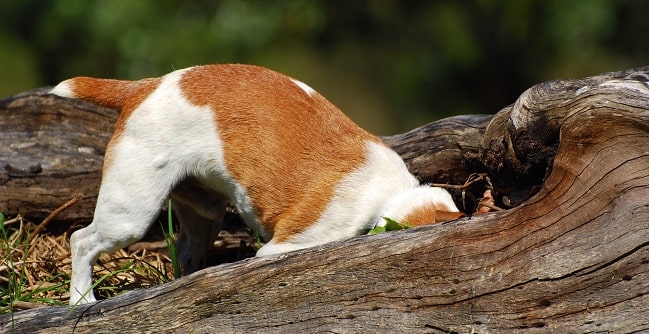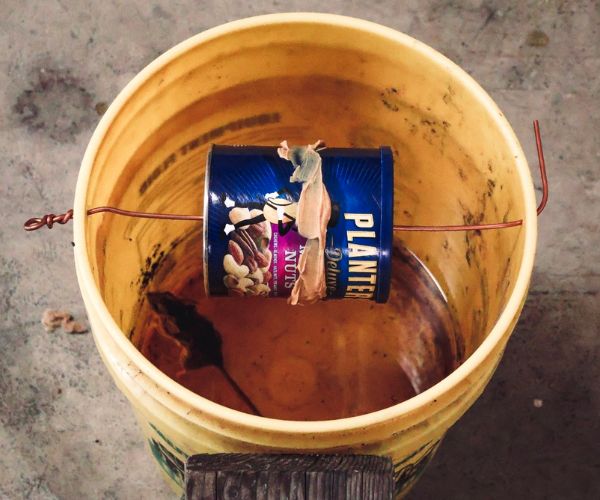Self-sustainable living is all well and good, but it often means sharing your home and its contents with other animals.
On our small holding in South Africa, we don’t just have a mouse problem. I’m not sure quite what type of rodent is living in my attic, but I can hear them now, stomping around on the ceiling like a troop of tap dancers in hobnail boots.
Not only is our local rodent population noisy, but it’s also destructive and disease-ridden. Between the striped field mice and South African vlei rats, we’ve seen wooden crates devoured, heavy-duty plastic tool boxes gnawed to pieces, leather boots chewed up and spat out.
I realize that there are some things I can’t change, like living in an old house that doubles up as a mouse condominium.
I have, however, decided I’m going to do everything else in my power to mouse-proof my food storage. I’m sick of picking mouse poop out of the rice and sharing my oatcakes with ransacking rats.
So, this is my 7-step campaign to reclaim my food from the jaws of the rodents:
Step 1: Clear the Way For Rodent Eradication
If cleanliness is next to Godliness, then mice are the devil’s number one allies. Leave a newspaper lying around, and they’ll turn it into a three-bedroom mouse house.
After getting some motherly advice and doing some in-depth research, I’ve decided to start by spraying a mixture of water and lemon juice onto the urine and feces. This solution is supposed to soften them and make them easier to remove.
Once that stage is complete, I’ll wipe down all the surfaces in the cupboards and the kitchen itself using pure peppermint soap as mice dislike its strong scent.
Step 2: Crack Down On Rat Access
The other reason our old farmhouse is such a popular place for rodents is that it has more cracks than Humpty Dumpty. I need to patch up those holes and reduce the number of entrances available to rats and mice.
The smaller cracks I can fill with a foam sealant, but the larger ones will need patching with steel wool or copper mesh.
The final step will be to add door sweeps to the bottom of my external doors, thereby blocking off a veritable network of rat highways.
Read about homemade rat poison.
Step 3: Get a Cat or a Killer Canine

We have a Jack Russell and, as small as she is, she’s a killer canine! Snakes, rats, mice, even bats stand little chance when she’s around. She’s not the neatest of destroyers, but she sure is effective.
Natural predators like dogs and cats play an important role in pest control, especially in a survival situation where they can help prevent disease and rodent infestations.
Step 4: Make a Mint With a Stink
Rats and mice have a keen sense of smell that we can use against them.
Rodents rely on their sense of smell to track down food so, strong odors, like peppermint oil, for example, can be both disruptive and irritating. Potent as it is, even peppermint won’t eliminate your mouse problem but can help to combat it as part of a multifaceted rat attack.
Other strong-smelling products you can use to deter mice include:
- Cayenne pepper
- Tea tree oil
- Cinnamon
- Cloves
- Lavender
- Mothballs
I’ve tried a few of these methods and can safely say that using mothballs to keep mice out of your cupboards will likely drive you away as well. Mothballs contain either naphthalene or paradichlorobenzene, both of which are toxic to humans.
I know mice are a nuisance, but they’re not annoying enough to risk your life for.
Essential oils, like peppermint and tea tree, are probably the easiest to use but need topping up regularly to keep the smell fresh. Powdered spices, like cinnamon and cloves, can be sprinkled wherever you see signs of mouse activity.
Step 5: Introduce Some Super Sonic Vermin Control
Sonic pest repellers sound great, but they’re only effective in certain situations.
The theory is that they emit a sound that humans can’t hear, but that’s irritating to your unwanted rodent visitors.
The truth is, most mice get used to the noise and start ignoring it within a few weeks.
What’s more, sound waves can’t travel through solid objects either, so sonic pest repellers won’t work very well in anything but the most minimalistic homes.
Despite these drawbacks, I’m going to get one and put it in the attic where the loudest rat parties take place. Even if it doesn’t get rid of them completely, it’ll hopefully make them take their boots off before dancing.
Step 6: Tap into the Traps

Rat and mouse traps come in various shapes and sizes, and the classic snap-trap is no longer the top option.
Avoid glue traps at all costs. No matter how annoying a rodent is, it doesn’t deserve to be tortured to death!
Humane traps, like those from Kensizer, are the best option for your conscience and are safe to use around pets, unlike a bait station trap which relies on poison. Better still, the mouse or rat won’t suffer either but can be re-released about 100 miles away and allowed to carry on life in someone else’s house!
If your rodent problem keeps recurring, changes are, relocation isn’t working, in which case, you may have to resort to more permanent measures. An electric mouse trap kills pesky rodents in seconds by delivering a high-voltage shock. The top-of-the-range models are also designed so you won’t have to deal with any crispy rodent corpses.
You could also DIY a simple bucket mousetrap.

Step 7: Upping the Ante in The Storage Department
Keeping mice and rats out of your emergency food supplies is an uphill battle that requires ingenuity and, in my experience, numerous canning jars and some large food-grade buckets topped with Gamma seal lids.
The one approach I’m going to try is to put my emergency food rations into Mylar bags and then into food-grade buckets – a method most preppers agree is the best option for long-term food storage containers. I’m also hoping this two-pronged method will eliminate the food’s smell so my marauding mice aren’t tempted to try gnawing on the plastic bucket.
I am a little concerned that the vlei rats will chew through the buckets for the fun of it, so I’m going to put my dried fruit and nuts into Mylar bags and then into tin canisters with airtight lids.
Conclusion
Rats and mice not only steal food, but they also spread disease, making them unwanted guests in your home and especially in your survival camp.
Using heavy-duty airtight storage containers is by far the best way of keeping pests out of your emergency food supplies, but there’s only so many of those you’ll be able to carry when the SHTF.
Rodent deterrents that have alternative uses mean less stuff to carry, so things like peppermint oil which deters spiders and wasps, as well as rats, and can be used as a disinfectant, are ideal for preppers.
Similarly, cats and dogs are great natural predators and double up as good companions and hot water bottles. Better still, they don’t need carrying!
If all else fails, you could also try these homemade mouse poison recipes.
While I’m relatively confident my 7-step rodent eradication plan will work, I still need all the help I can get, so if you have any other ideas or suggestions about how to mouse-proof food supplies, please share them in the comments below.



I’ve found that dryer sheets like Snuggle and Downy repel rodents. I put them inside storage totes, rv’s, horse trailer, in and around leather tack. It’s not guaranteed, but I can’t remember a tote box that had evidence of mice that had a dryer sheet placed inside of it.
WELL:. tried Rat-X / dried kidney beans / baking soda / neem bark powder which is supposed to stop reproduction //\\ and as for REPELLENTS “”haha”” I swear those and the PIC Sonic Repeller Bulbs actually invited more to visit / I planted Peppermint, Spearmint, Lavender, Marigolds around the outside of my house and they are dining on them and sleeping under them……they stroll through pepper, chili, garlic powder and even Diatomaceous Earth leaving cute footprints BUT I HAVE DOGS and YES they love catching them and think they are SQUEAKER TOYS before killing them “”so I CANNOT USE POISONS””; BUT I WANT THEM OUT.! Now What??
I have collected popcorn tins – the tins at Christmas time holding varieties of flavored popcorn – and store grains in them. Over time, the manufacturers have made the tins smaller. But they do solve the rodent problem.
We had a mouse get caught but not killed in a trap once, and he squeaked quite awhile, I assume, until someone came home to take care of him. The mice avoided that area from that time on. That batch of them did. (Until we got a new batch some time later.) I wonder about recording sounds of rodents in distress, and putting the noise on to play back…
Have the kindness to kill the glued down mice or a stun baton for a quick zap death.
Leave out dehydrate potatoes. Mice love them – until they tank up with water!!!
Unfortunately, releasing animals far away from where you trapped them isn’t humane. They’ve been removed from the habitat they know, where they know where to find food, water, and shelter, and dumped somewhere unfamiliar. They don’t know where to find food, water, or shelter in the new environment, and there are likely resident rodents already in the area that will run them away from any resources or kill them outright.
Additionally, if the animals you transport have any diseases or parasites that aren’t local to the new area, you may upset the ecosystem in the new area.
Transporting and releasing animals is illegal in the United States, presumably mainly for the reasons mentioned above, but I don’t know about the laws in other places.
I’m currently looking for ways to keep food safe from / unattractive to mice (so far no mice in the food, but they’re definitely in the walls). I’ve dealt with trying to keep them from nesting on my car’s air filter — the only successful method I found was to pull out the air filter every time I parked.
What about water bucket traps? 5 gal pail,soda can, dowel rod, Bingo !
That would work, but not in the long term. You’d have to keep refilling the water traps around the food. I prefer to pack my food in Mylar + OAs, put it in buckets, and then basically forget about it (I do rotate through it eventually, but after a long time).
Yes, sometimes there’s no getting around the reality of “either him or me”…..in which case, i chose me.
sorry but I don’t have the same compassion for rats & mice like you – everything is fair in love & war – and saving your food and property from rodents is definitely war >>>>
there’s smart azz rodents that can only be caught with glue traps – they even know enough to avoid the posted poison bait >>> keep a eye on the traps and stand ready to drown them in a humanitarian manner ….